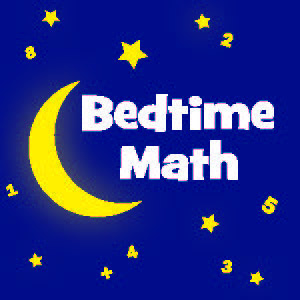Bedtime Math: Break the Cycle of “Math Anxiety”

 Let’s face it: math doesn’t win many popularity contests. Plenty of grown adults freely say “Ewwww, math!” or “I’m just not good at math.” But we never say “I’m just not that good at reading,” do we? We tend to be great at showing our kids our love of books, and as parents, we know we should do the same for math – whether your child is aiming for one of tomorrow’s high-tech jobs or just needs to figure out which new gadget is a better deal, a solid foundation in math will help them succeed.
Let’s face it: math doesn’t win many popularity contests. Plenty of grown adults freely say “Ewwww, math!” or “I’m just not good at math.” But we never say “I’m just not that good at reading,” do we? We tend to be great at showing our kids our love of books, and as parents, we know we should do the same for math – whether your child is aiming for one of tomorrow’s high-tech jobs or just needs to figure out which new gadget is a better deal, a solid foundation in math will help them succeed.
But here’s the catch: how can a mom who has “never been good at math” help her children like math and gain confidence in their own math skills?
The truth is, math anxiety is widespread in our culture. Many parents believe math is harder than reading and avoid discussing math with their kids. What’s more – and this is a bit scary –many of today’s elementary school teachers admit to a lack of confidence with their own basic math skills. So it comes as no surprise that lots of kids pick up the attitudes of the adults around them and start to doubt their own ability to succeed at even the simplest math.
At our house, things are different. My husband and I have done fun, mischief-loaded math problems with our kids at night for years, and when at age 2 our third child started hollering for his own math problem, we realized we were onto something. In a world where people fear math, we had created a household culture where kids don’t just tolerate math, they actually seek it out. And that led to the birth of Bedtime Math.
The goal of Bedtime Math is to break the cycle of “math anxiety” by helping kids get comfortable with math while they’re young and still open to loving it. We send parents a fun, new math problem every day to do with their kids. It starts with a brief set-up story – electric eels, chocolate chips, zip lines into the neighbor’s pool – then asks math questions at three levels of challenge, covering preschoolers through second grade and up. It’s not enough for the math problems to be kid-friendly: they have to be kid-appealing. The problems help kids relate math to the playful things they love in their everyday lives. Not only are kids enjoying it, but we’ve also had parents write in to say they’re starting to like math for the first time, too.
Our hope is that by making the nightly math problem as common as the bedtime story, we can change the way our culture views math.
Try the sample problem below with your kids, or visit us at www.Bedtimemathproblem.org to see more problems or sign up for our daily email.
Follow Bedtime Math on Facebook or Twitter.
SAMPLE PROBLEM
Getting Antsy
If you’d like to have thousands of insects as pets, you can get yourself an anthill. If you prefer furry pets, you can get an anteater. Rest assured, you can’t keep both at once. The anteater, as its name would suggest, does in fact eat ants as a major part of its diet, along with termites. From its long snout shoots a skinny tongue that can worm its way deep into anthills and pull out a nice serving of bugs for dinner. And since an anteater can flick its tongue 150 times per minute, it can grab a lot of ants in just one brief sitting. Try slurping up your dinner that fast, and you’ll find you can barely keep up.
Wee ones: If your pet anteater eats 5 ants for breakfast, and you decide to try it yourself and you eat 3 ants, how many ants did the two of you eat together?
Little kids: If your anteater flicks its tongue 3 times and picks up 200 ants each time, how many ants did it eat? Bonus: If your anteater flicks its tongue 13 times in the next few seconds, takes a quick break, and then does 9 more tongue flicks, how many times did it flick its tongue?
Big kids: Anteaters visit about 200 bug nests in a day. If an anteater eats 35,000 ants in one day from 100 anthills, how many ants did it score from each nest on average? Bonus: If your pet anteater flicks its tongue 150 times in one minute, how fast can it flick it 15 times?
Answers:
Wee ones: 8 ants in total – yum.Little kids: 600 ants. Bonus: 22 tongue flicks.
Big kids: 350 ants. Bonus: 1/10th of a minute, or a mere 6 seconds.
 ABOUT LAURA: Laura Bilodeau Overdeck is founder and president of Bedtime Math, a nonprofit that seeks to make math as common and natural a ritual as the bedtime story. Bedtime Math offers a fun, free daily “recreational” math problem for parents to do with their children, which engages parents while putting math on equal footing with literacy. In its first six months of existence, Bedtime Math has increased its regular following from 30 families to over 20,000, and has garnered national press coverage multiple times.
ABOUT LAURA: Laura Bilodeau Overdeck is founder and president of Bedtime Math, a nonprofit that seeks to make math as common and natural a ritual as the bedtime story. Bedtime Math offers a fun, free daily “recreational” math problem for parents to do with their children, which engages parents while putting math on equal footing with literacy. In its first six months of existence, Bedtime Math has increased its regular following from 30 families to over 20,000, and has garnered national press coverage multiple times.
Laura also currently serves as Chair of the Advisory Board for Johns Hopkins’ Center for Talented Youth (CTY) and as a trustee of Liberty Science Center, Drew University, and the Governor’s School of New Jersey. She holds a BA in astrophysics from Princeton University, and an MBA from the Wharton School of Business.
While Laura has only limited math tutoring experience, she does know something about numbers. As a child she sat and memorized perfect squares for fun, back before it was cool. When not playing with numbers, Laura’s other interests include chocolate, wine, extreme gravity stunts, and Lego Mindstorms.
Visit Bedtime Math at www.Bedtimemathproblem.org






